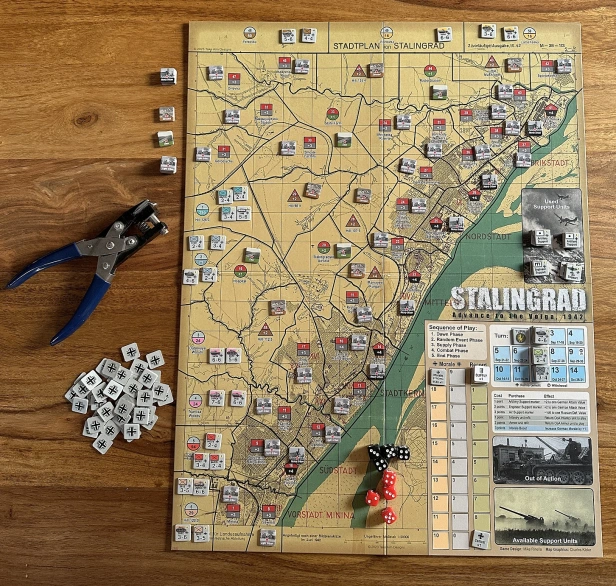| About game: | First of all, let us do a brief introduction of Stalingrad Advance to the Volga, 1942. This game puts the player in charge of the attacking and far more mobile German side while the game system handles the defending and largely static Soviet side. Because Soviet defenders are set-up in a hidden & random way (according to terrain – Open, Elevated, Light Urban, Heavy Urban) no two games will ever be the same. Each turn will represent new and unique challenges for the player – you will roll on event table and see in what way your army and forces will be hampered (reflecting actual, historical difficulties). Then, you will get your supplies – random amount, depending how much the OKW was willing to send. You will decide how to spend them, be it on supporting units, rebuilding destroyed formations or investing in so-much-important morale. Only then you will be able to activate your units, enter enemy occupied territories and learn what is the true strength of opponent and which defensive tactic (Ambush, Fanatics, Guards, Heroes, Barrage) it shall use. Be careful – if you do not overcome enemy and get entangled into the fight in the Urban area, you might suffer the “Bloody Streets” effect (war of attrition in dense Stalingrad building).
So, would you stand-up to the task, use your assets wisely and achieve a result better than historical in the battle of Stalingrad? |
| Number of players: | This is pure solo game. One might experiment with second player setting the Soviet defenses on map and doing some of AI actions, but I doubt it will be much fun. |
| Playing time: | We have here two scenarios here – Full Campaign (9 turns, initial attacks in September) plus a dedicated Factory District Scenario (5 turn, late October). The first can take even up to 4-5 hours, especially when played first time. The second, with some experience, you will easily finish in up to two hours. |
| Complexity: | That could be treated as one of the better introductory solitaire wargames. Not overly complex, with straightforward AI mechanics, where most decisions are on your Axis forces. Prefect to play on your own. |
| What I like: |
|
| What I do not like or would like to see in the game: |
|
| For whom? | That one will give a lot of fun both to seasoned wargamer, who wants to play something lighter solo. On the other hand, that can be a great entry game for new adepts of our hobby, looking for a good solitaire game to start with. |
| More about the game: | |
And now let us have a look at the materials created by me plus some pictures of components:

VERDICT:

In summary, I admit that I simply had fun playing that game. A very nice mechanics, straightforward rules, good playbook, beautiful components plus smaller and larger scenarios – definitely, designer though about all angels here. As mentioned, both grognards as well as new players will spend enjoyable time with this title. And if you ponder, what might be the next logical step in the series, check this out: Manila: The Savage Streets, 1945.
Highly Recommended!




Thank you for this detailed review. If I see it somewhere I will buy it.
LikeLiked by 1 person
My pleasure; really liked that game.
LikeLike
Thanks for nice review. I like this game (played only twice until now).
In february there i supposed to be reprint, because it i sold out.
It can be tedious and frustrating, but it is how battle od Stalingrad should be.
Some are complaining that Soviets are just static. And I do not agree. This solution makes the game easy to play, without spending much time managing of oponent. Soviet movement is kinda abstract, so if you want you can see it there.
Last game I attacked and it was stalemate then there was bloody streets and I got spent and lost morale (you can see it as soviet counter attack) and next turn I did lose combat and was repulsed (another Soviet counter offensive and succesful)… So just in one Area I did have 2 Soviet counteroffensives. It is just abstracted for the good of smooth play 😉 Looking forward to Manila.
A zdravím z Česka. 🙂
LikeLiked by 1 person
Thank you for kind words; I agree that design decision is great – minimal management of AI opponent but very interesting, dynamic gameplay each time. And I can’t wait for Manila, so second part of the series!
LikeLike
Yep, definitely getting Manila and looking forward to Berlin 🙂
LikeLiked by 1 person